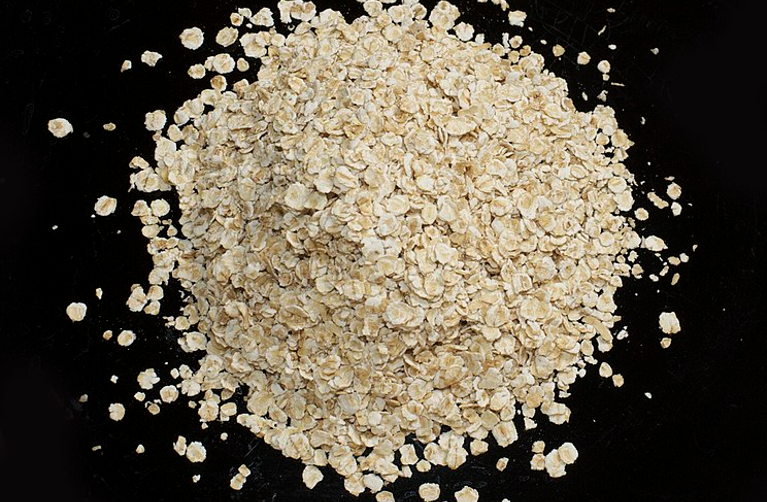Contemporary ‘consumer’ veganism has an over-packaged/over-priced credibility issue. This is especially true of plant-based milks, and their impact compared to ‘DIY’ options. In this post I explore how you can avoid this by making your own oat milk – cheaply, easily, and with minimal waste.
In this part I outline how to make one of the simplest plant milks – oat milk. It is SO simple to make oat milk. For that reason most of this part will be about the comparison between ‘DIY’ and buying from a shop, rather than actually making oat milk. That’s precisely because plant milk is one of those products that exposes so many of the internal contradictions that plague the modern ‘consumer vegan’ diet.
I learned about ‘being vegan’ at peace camps and activist squats in the mid-1980s. We were few, but wow!, could we throw a party in any location with minimal resources! In the interim four decades my view of this has become far more nuanced, but it hasn’t lost the ‘hunger’ that I had in the early-80s.
Thing is, when I see what people are buying and consuming as part of the vegan culture of today, it often makes me cringe. There may be a burgeoning amount of vegan ‘products’ to be bought in the shops now; but given their essential characteristics, and excess of packaging, do they actually represent any real change for the principles they claim?
Many times I’ve tried to say this via (anti-)social media discussions; where often the response has been lukewarm to positively hostile. Here I’ll relate those same details on why people need to think more deeply about the impacts of their diet.
Almost 40 years on, the pattern of how veganism is – quite literally – “sold” today presents the complete opposite to the ‘deep green’ approach that inspired me: Modern veganism is not, as I perceive it, a practise rooted in seeking connection to the Earth and all life thereon; it’s simply mainstream consumerism, with all its deleterious impacts on animal life, re-branded for a more affluent audience.
Contemporary veganism isn’t critical of consumerism, only animal farming
Most of the weight of ‘animals’ on the planet are not ‘wild’; they’re part of the human economic system. When I found that out, a few decades ago now, reading books like ‘Diet for a Small Planet’[1], it changed what motivated me to eliminate meat and dairy from my diet. What started as a seemingly more interesting, cheaper, and more convenient option, took on a new ‘deeper ecological’ perspective[2].
Forty years ago, if you wanted a vegan diet you had to make it for yourself: Often collectively buying the ingredients in bulk; and then you had to learn how to prepare the meals you wanted to eat.
Thing is, at that time this wasn’t a chore. It was 100% ‘punk DIY’[3]: Within the burgeoning ‘DIY Culture’[4] that spread across the country, in the wake of the depression of ‘Thatcher’s Britain’, there was a complete and virtuous connection between organising your own diet, excluding where possible corporate entities, and as a result resisting that newly dominant neoliberal consumer culture.
That can’t be said of veganism today. It’s become part of general consumer culture: Ostentatiously virtuous (if you believe the advertising hype); and bathed in the convenience and consumer simplicity that pervades the food culture of society today.
The problem is, as part of that simplification process, and the desire by manufacturers to exclude any ‘critical’ issues that can’t be reworked as advertising spin, veganism has lost its power as a force for change. ‘Consumer veganism’ doesn’t challenge contemporary industrial/technological culture, and its impact upon the planet and living organisms; it is uncritically suffused with those ‘industrial’ values.
For example: Why make plant milk at all?
Dairy products[5] became part of the human diet over the last 3,000 to 5,000 years; since animals were first domesticated, and then bred for milk production. But the ability to digest that milk took time to adapt. Still today, up to two-thirds of humans may not perfectly digest dairy products, and 2% may be strongly allergic to the lactose they contain. Up to 5% may be allergic to the caseins in milk, and especially when made into cheese.
For most, milk is not an essential, irreplaceable part of their diet. The large surfeit of dairy-based ingredients we see today (e.g., whey powder) are the result of recent mass manufacturing[6] food technologies, not food tradition. It is that same culture that now drives veganism, not older ‘meat-free’ traditions.
Making oat milk
Making oat milk is simple – as explained in the next section.
Oat milk is made from three things: Water; oats; and energy. That last part, the ‘energy’ provided by your arm or the power socket, changes the ecological equation. How you do that is up to you, but bound-up within that are the factors which tie you, and your lifestyle, to the broken and exploitative globalised food system.

For me, the major issue with oat milk is price – as shown in the table above. Vegan products are often priced higher relative to non-vegan equivalents; and often that price is structured to attract a more affluent demographic (as shown by the fewer vegan product lines carried by the ‘less exclusive’ supermarket chains).
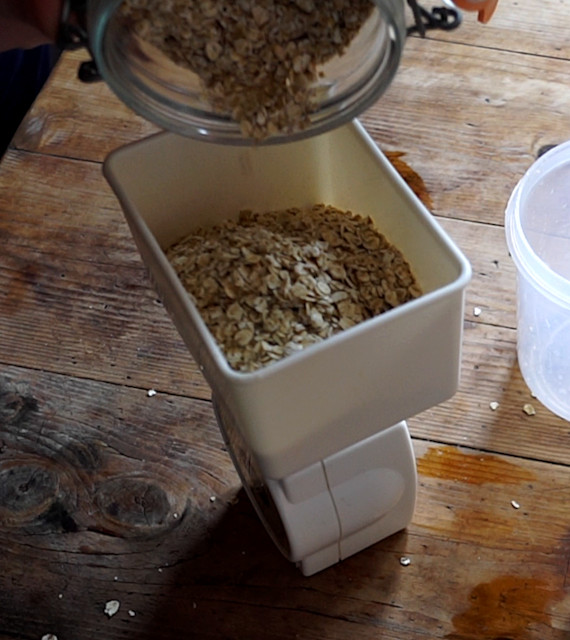
Measuring-out 100 grams oats to put into soak – to make half-a-litre of oat milk.
For me, buying oat milk is prohibitively expensive compared to the costs of ‘DIY’. Making anything from half to three litres of oat milk takes about the same amount of time, 30 minutes: Measuring and putting oats into soak (5 mins); making the oat milk (20 mins); then tidying up (5 mins).
Economists argue it’s more ‘efficient’[7] to go out to work and then buy the oat milk.
Making a litre or two takes an incidental 30 minutes over a day – alongside other cooking activities in the kitchen. Rather like the arguments over agriculture, this isn’t ‘monoculture’, it’s ‘polyculture’: Making oat milk is integrated into the many other activities I undertake to live as simply and cheaply as possible; and the simplistic reasoning of ‘economic science’ cannot allocate the true value of those various activities. The time used to make oat milk is incidental to other work in the kitchen; it’s ‘recreation’, not ‘work’ – and so it can’t be reduced to hard economic values.
More importantly, making it yourself extends your personal choice. Take, for example, the consistency of the oat milk: I like my oat milk ‘thick’. The only oat milks that approach that are the more expensive brands (£2/litre or more) which contain a higher proportion of oats. I find most oat milks to be too watery, and lacking in taste as a result.
Finally, I always make more oat milk than I can easily use. What I can’t use immediately I freeze into blocks (pour into a small plastic container; freeze; remove block from container and then store in a bag or box in freezer until it is required). If you want to freeze oat milk, it’s better to do this before you dilute it because it takes-up less space, and takes less energy to freeze as well. When you thaw it out, you can then add water to make the consistency for the recipe or use required.
How to Make Oat Milk – by hand, or using an electric blender
Step 1. Select your oats
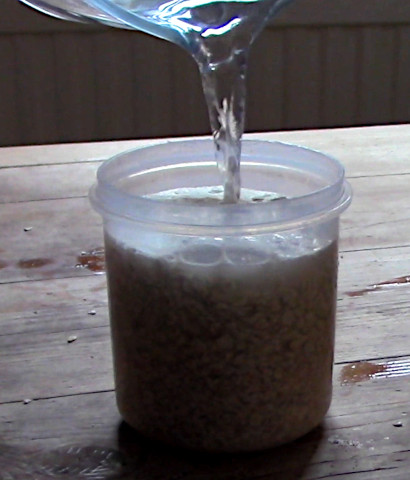
Soaking the oats in water to make oat milk.
You need oats. Oats come in different forms:
Traditional oats, such as you might glean from local fields or grow yourself, are fibrous little lumps that need a little extra effort to process;
Rolled or porridge oats have been put through a roller mill, removing the hard outer husk of the traditional oat, and then rolling the grain flat to make it easier to soak-up the fluid added to it;
Jumbo-oats are a special cultivated variety of oat that are far larger, and have a proportionately higher quantity of flour in them; and finally,
Oatmeal/oat flour has been completely milled and sieved into flour – and can be used to make ‘instant’ oat milk without the need for prolonged soaking or straining. But I find oatmeal-based milk has a powdery rather than smooth taste.
Which to use is a matter of preference or taste: Practically porridge oats are often cheaper than jumbo oats – and the extra flour in jumbo oats sometimes gives the milk a more slimy texture; Oatmeal, on the other hand, results in something that’s very slimy, in part because without the fibre the flour acts just as a thickener to the water; Traditional oats are OK, but they do require a little extra work (by hand) compared to porridge oats.
Step 2. Soak the oats
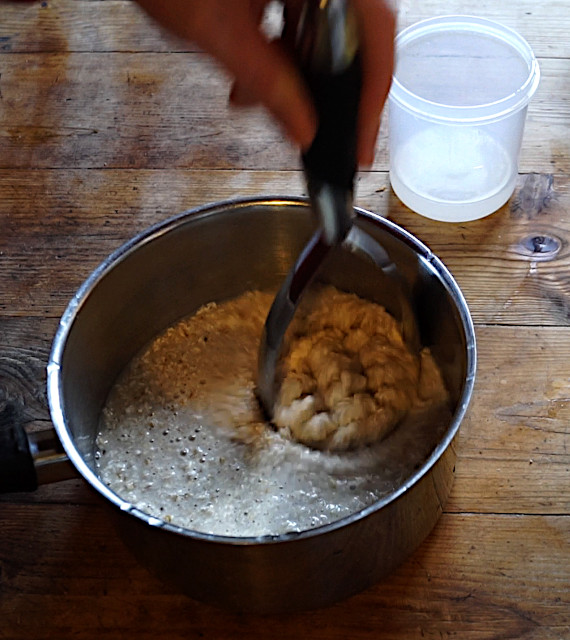
Mashing the oats with a hand masher in a saucepan.
Theoretically if you quickly douse the oats in boiling water, stand for a few minutes, and then use a lot more energy pounding the oats, you can skip this step. Practically, though, soaking saves effort later, and extracts more of the flour into solution.
Take about 100 grams/a cup of oats (this should produce between 500ml to 800ml of oat milk).
Put in a container. Fill to just above the level of the oats with water. Then allow to stand for two to six hours while the oats soak-up the fluid. It won’t hurt if you soak them for up to 12 hours overnight, or while you’re out at work.
If you are using oatmeal you don’t need to soak, blend or sieve; but it’s a good idea, after beating the oatmeal into the water, to let it stand for ten minutes or so until the flour becomes fully saturated.
Step 3. Drain and blend
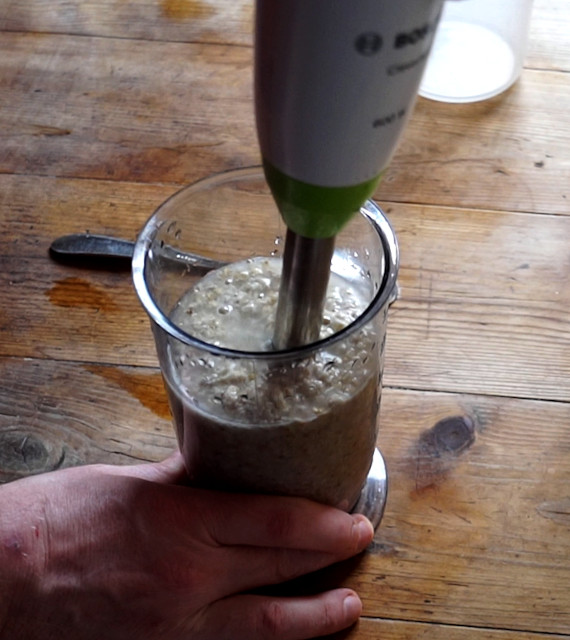
Blending the oats with a hand blender.
If you are using an electric blender: You can just tip the oats and water into the blender and press the button. Some people drain the water and replace it with fresh. Either way, you will need to add some water to the blender to allow the mass of oats to flow and get chopped to pieces. Run the blender until the contents are fairly uniform, and any dark lumps have disappeared – which can take a minute or two, longer if you are using traditional oats. Finally, if the mixture is still fairly stiff, add a little more water until the mix becomes sloppy.
If you are using a hand masher: Drain any free liquid out, put into a hard, flat-bottomed metal container, and then mash. As you pound the oats into pieces, add a little more water as you go to keep the mass fluid, but not sloppy. Eventually when most of the lumps have gone, add more water and pound until the mix becomes a sloppy soup.
Step 4. Strain

Straining the mashed oats through fine-mesh metal sieve.
Some recipes advise straining through a muslin cloth. Others suggest using those very expensive ‘nut milk’ bags. Personally I find a very fine mesh metal sieve works just as well, but more importantly, is a whole-lot easier to clean-up afterwards.
All straining does is remove the remaining fibrous lumps from the mix to create a smooth fluid. Whether blending or mashing, it’s a good idea to mash/blend, then sieve, then add more water to the sieved left-overs and repeat those steps – to extract as much milk from the oat mass as possible.
Most importantly: Don’t throw-away the ‘discards’ from the sieve – they make an excellent thickener for stews, or can be used in flapjacks or lembas scones[16] to add fibre and protein.
Step 5. Dilute
One of the great benefits of making your own oat milk is that you get to choose how ‘thick’ you want it. It might be that you want a thicker mix to make custard; or you might want a thinner liquid for use in drinks or on cereals.
Very simply, add water until the oat milk is the consistency you want for the thing you need it for.
Step 6. Additives
Finally, when it’s diluted to the required volume, you can add extra things to it:
Sweeteners – you can add sugar (brown is better), although if you really want to add sweetness and nutrition you can dilute a spoon of barley malt in a little hot water and then add that to the milk;
Fortification – if you want to add vitamins and minerals the easiest option is to take some fortified yeast flakes, dissolve them in a little warm water, and then add to the milk;
Flavours – once made you could whisk/blend in a little cocoa, or add a little vanilla essence, nutmeg, or a flavoured syrup, to create an oaty shake.
The packaging problem
Shop-bought oat milk, of whatever variety, has something very important which my own-made oat milk does not – packaging waste[8]. A typical ‘plastic-coated paper’[9] carton for food use has one layer of card (70% by weight), one layer of aluminium (5%), and three layers of plastic (25%).
Let’s look at a rarely considered issue in this debate – water use.

The layers within a typical plastic-coated paper drinks carton
According to Tetra-pak’s[10] own life-cycle analysis[11] report, to create a 1-litre drinks package requires almost 2½ litres of processing water, and almost 1½ litres of cooling water.
In bold, just to make this point more loudly: Producing a 1-litre carton to hold oat milk (containing 0.9 litres of water) takes over 3½ litres of water.
As the LCA report says, that’s better than glass bottles. But what about the ‘DIY’ option? Making a product yourself, from bulk-bought ingredients, and storing in a reusable container? That is never explored because it challenges the core assumption of the consumer lifestyle: Buying as much stuff as possible, throwing it away, then buying more.
Plastic-coated paper cartons are ‘theoretically’ recyclable[12], but the energy and resource costs of doing so, and the low-level of reclamation, mean the value of this is low. By any reasoned measure, recycling these cartons is overtly PR ‘greenwash’[13] to make consumers feel better about buying them.
For me, making five to six litres of oat milk creates one empty 2 gram plastic oats bag as waste – as I reuse all the ‘discards’ from making the milk in cakes or stews. In contrast, six empty 1-litre containers together weigh 65 to 90 grams – depending whether it has a plastic screw lid or not.
It would be possible to produce a similar life-cycle analysis of ‘own made’ oat milk. But it’s an awful lot of work for a result which is absolutely clear from the outset: ‘DIY’ is more efficient in terms of ecological impacts; and if only those impacts on the planet were priced realistically, then the economics of ‘buying’ versus ‘making’ would tip towards ‘DIY’ by a staggering amount.
Why do industry and government refuse to enact measures to control climate change, ecological destruction, and drastically reduce energy consumption and pollution to within ‘planetary boundaries’?[14] Precisely because such measures would mark the end of the modern, ‘affluent’ consumer culture.
More peculiarly, why do ‘green consumers’ believe they can buy their way to ecological sustainability through using the right products?; rather than changing that lifestyle of ‘convenience’ for something simpler. The objective facts speak for themselves.
Questioning assumptions
I do not take ‘milk’ in my drinks. I use oat milk for more ‘culinary’ needs – like making custard, puddings, or as a thickener. I also make soya milk and then tofu – but that’s for another day, as it raises many more complex issues.
Milk in tea or coffee is an affectation, the product of first wealth (you could afford to buy what was a rare commodity in early urbanised Britain), than mass industrialisation (which created intensive agriculture, and large-scale dairying operations).
In contrast, ground or boiled grains have been a part of human food culture for over 10,000 years. Oats were one of the earliest grains used for food, but in the modern era they have become a tradition in the temperate north – where the crop can withstand the damper, colder climate more easily.
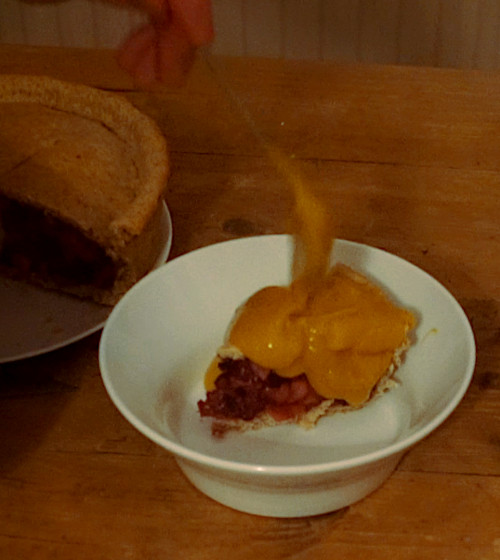
Oat milk custard on an own-made foraged blackberry & apple pie.
Why then do people expect to have ‘milk’ in their drinks, or on their cereal? Picking-apart that history, certain trends arose only recently in industrial society as their use was made possible by mass production and improved transport links; and the systems of, often exploitative, economic or trade relations which arose as a result of these[15].
As we move into an uncertain future, where ecological overshoot and climatic change portend a break-down of that mass consumption system, ‘do it yourself’ represents the simplest option to meet our needs. Learning how to do that, starting with the simple things like plant milk, is a means to learn these skills to prepare for that eventuality – as well as saving money, and ecological impacts, compared to today’s shop-bought options.
References
- Ramblinactivist’s Blogs – A Book in 5 Minutes: No.5, ‘Diet for a Small Planet’, September 2021.
http://www.fraw.org.uk/blog/reviews/004/index.shtml - Ramblinactivist’s Blogs – A Book in 5 Minutes: No.7, ‘The Deep Ecology Movement’, January 2022.
http://www.fraw.org.uk/blog/reviews/007/index.shtml - Wikipedia: ‘Punk subculture’.
https://en.wikipedia.org/wiki/Punk_subculture - Wikipedia: ‘Do it yourself’.
https://en.wikipedia.org/wiki/Do_it_yourself - Wikipedia: ‘Dairy’.
https://en.wikipedia.org/wiki/Dairy - Geography Compass: ‘Political ecology of milk – Contested futures of a lively food’, vol.14 no.8 art.e12497, August 2020.
https://compass.onlinelibrary.wiley.com/doi/full/10.1111/gec3.12497 - Wikipedia: ‘Comparative advantage’.
https://en.wikipedia.org/wiki/Comparative_advantage - Foodprint: ‘The Environmental Impact of Food Packaging’.
https://foodprint.org/issues/the-environmental-impact-of-food-packaging/ - Wikipedia: ‘Plastic-coated paper’.
https://en.wikipedia.org/wiki/Plastic-coated_paper - Institute for Energy and Environmental Research, Heidelberg: ‘Comparative Life Cycle Assessment of Tetra Pak carton packages’, 9th March 2020.
https://www.tetrapak.com/content/dam/tetrapak/publicweb/uk/en/sustainability/2020-lca-tetra-pak-european-market.pdf - Wikipedia: ‘Life-cycle assessment’.
https://en.wikipedia.org/wiki/Life-cycle_assessment - Ethical Consumer: ‘A guide to environmentally friendly packaging’, December 2020.
https://www.ethicalconsumer.org/food-drink/guide-environmentally-friendly-drinks-packaging - Wikipedia: ‘Greenwashing’.
https://en.wikipedia.org/wiki/Greenwashing - Wikipedia: ‘Planetary boundaries’.
https://en.wikipedia.org/wiki/Planetary_boundaries - Long Walks & Anarcho-Primitivism: Part 3, ‘Wild tea making and the revolt against the machine’, Sap Moon 2021.
http://www.fraw.org.uk/lwap/posts/03/index.shtml - An Anarchist’s Cookbook: Part 2, ‘Lembas Scones’, Sap Moon 2021.
http://www.fraw.org.uk/aac/posts/02/index.shtml
Teaser photo credit: By Bill Ebbesen – http://en.wikipedia.org/wiki/File:Oatmeal.jpg, Copyrighted free use, https://commons.wikimedia.org/w/index.php?curid=11612471


